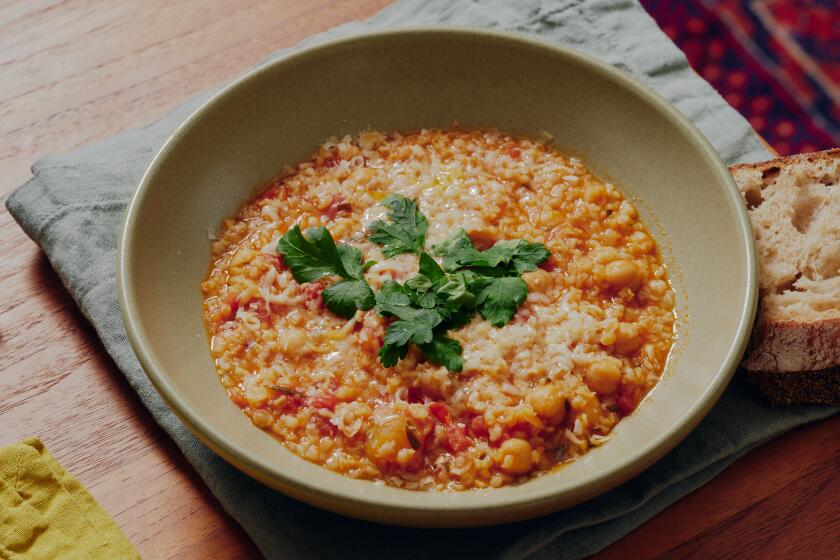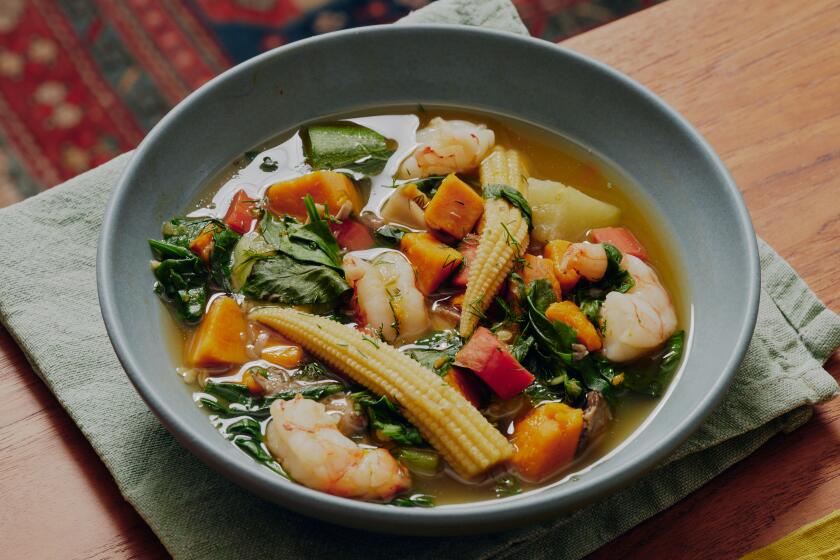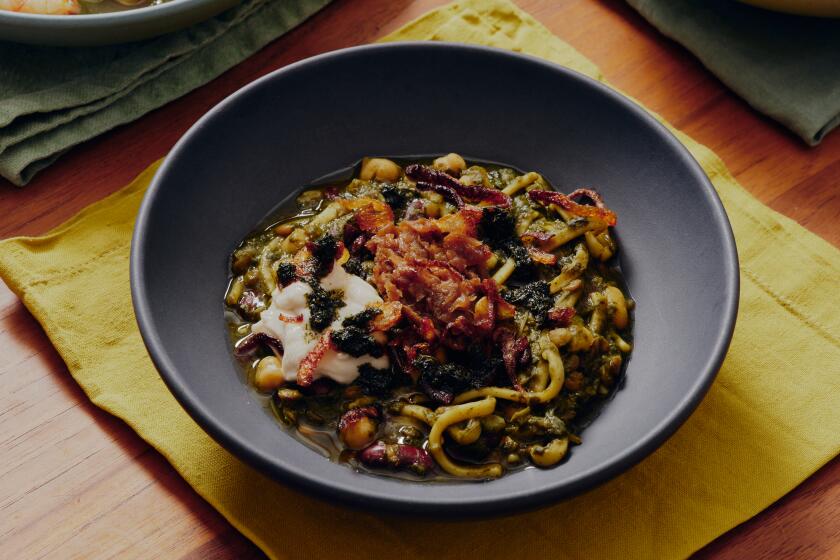"Spotsy" Soup

Rivels means lumps. Children in Pennsylvania Dutch communities learn this at an early age. That’s because rivels are loved by every child, much like macaroni and cheese. It’s a fondness few outgrow.
Growing up with a Pennsylvania Dutch grandmother, I discovered rivels with my very first bowl of her “spotsy soup.” At least that’s what we kids called it. To Grandma Filson, it was what she served her large family during the Depression and whenever times were hard. My parents grew up on it, and so did I.
Grandma might have made it because it was so economical--little more than water, a potato and dumplings--but we just loved this stick-to-our-ribs soup because of how it tasted. It was the rivels that made it completely irresistible.
Rivels are tiny egg dumplings made by dropping bits of batter into boiling liquid until they rise to the surface, light, plump and slightly chewy. In parts of Germany and Alsace, rivels are known by other names, such as spaetzli, spatzen or spaetzle.
When Grandma’s family immigrated to rural Pennsylvania centuries ago, they brought many recipes from their home in the Rhineland of southern Germany. They were among those called the Pennsylvania Dutch, who lived simply on what their land could provide, valuing the virtues of hard work and self-sufficiency.
Although their German recipes evolved to reflect the foods available on their American homesteads, many of Grandma’s Pennsylvania Dutch specialties clearly show their Old World heritage--such as her endless meat-and-dumpling dishes.
Like generations of Pennsylvania Dutch women, Grandma was a genius with food. She had to be. The family’s survival depended on her ability to gather and put up foods to see them through the winter.
Especially remarkable was her talent at transforming the most modest ingredients into satisfying meals day after day. It’s this resourcefulness that defines Pennsylvania Dutch cookery. It epitomizes simplicity, and its dishes are warm and nourishing--in other words, just plain comforting.
Grandma used rivels in many ways. She plopped them into soups to make them more substantial--sometimes merely meat or vegetable broths, perhaps delicately enhanced with spring greens and herbs, other times hearty chicken and corn chowders, or ham and bean soups.
When times were good, we enjoyed rivels with her German meatballs, pork chops, smoked sausage and pork roast, sometimes alongside homemade sauerkraut or pickled red cabbage. As side dishes they were drizzled with or fried in butter and tossed with all sorts of luscious things such as caraway seeds, cheese, sour cream, fried onions, bacon or browned bread crumbs. We liked them better than potatoes, filling our plates, and even drowning them in meat gravy when we could.
Visiting the homes of friends, I discovered every Pennsylvania Dutch family makes rivels differently. Although I love them all, I remain partial to Grandma’s. She was never one for gadgets, and her low-tech method is still the one I use.
It can be replicated in any kitchen. Start by stirring together flour, salt and eggs with just enough milk to give the right consistency. “The more eggs, the more tender the rivels,” she’d say. One egg and about 1/3 cup of milk per cup of flour was typical of hers. Watching her, I learned that the “right” consistency is a gloppy mixture that’s thicker than cake batter but not as firm as dough. It just mounds in a spoon.
Tilting the bowl of batter over boiling salted liquid, take a kitchen spoon and scoop out teaspoon amounts of batter and quickly drop them into the liquid. The spoon makes a fleeting dip into the water, too, to help the batter fall off cleanly. The little dumplings that form will be varied in size and shape, which makes them more fun to eat.
To keep the rivels separate while they cook, give them an occasional gentle stir and be careful not to overcrowd the pot, so that the liquid is always simmering. Within minutes, the rivels rise to the top and are done. They’ll have fattened two or three times in size and have a delicious chewiness. If they aren’t being left in a soup, scoop them out of the cooking liquid with a slotted spoon, drain, then enrich them as your heart desires.
Equally practical, some cooks mix their rivel batter a bit thicker on a large cutting board and cut off small pieces with a flat butter knife and drop them into the boiling liquid. Other rivel-makers press the batter through a large-hole colander, a ricer or a spaetzle press. This makes little round squiggly noodles of a more consistent size.
For another style of rivels, some Pennsylvania Dutch women make them without milk, then crumble bits of the dry dough between their fingers and drop them into boiling liquid. Their rivels are rice- or pea-sized and, I think, best for thickening soups and stews.
No matter what type of rivels are made, they’re not much to look at. Lumpy, misshapen little blobs of dull beige dough, they bob around in everyday soups whose initial purpose was to feed a family fast, using whatever was in the larder.
I loved rivels as a kid, but nowadays they make even more sense to me. Not because they’re practical or delicious, but because whenever I settle down to a big bowl of them, their familiar taste is what I really hunger for.
Melt the butter in a large soup pot or Dutch oven over medium-high heat. Add the onions and cook, stirring, until golden brown but still soft, about 5 to 8 minutes.
Add the stock, potato and salt and pepper to taste. (Grandma used water instead of stock, but I find stock adds a nice meaty flavor.) Lower the heat to medium, cover and simmer until the potato is just tender, about 15 to 20 minutes.
Uncover. Press the rivel batter through a colander with 1/4-inch holes into the soup (or use a ricer or spaetzle machine). Boil gently, stirring once or twice, until the rivels rise to the surface and are tender, about 5 to 10 minutes.
Get our Cooking newsletter.
Your roundup of inspiring recipes and kitchen tricks.
You may occasionally receive promotional content from the Los Angeles Times.















